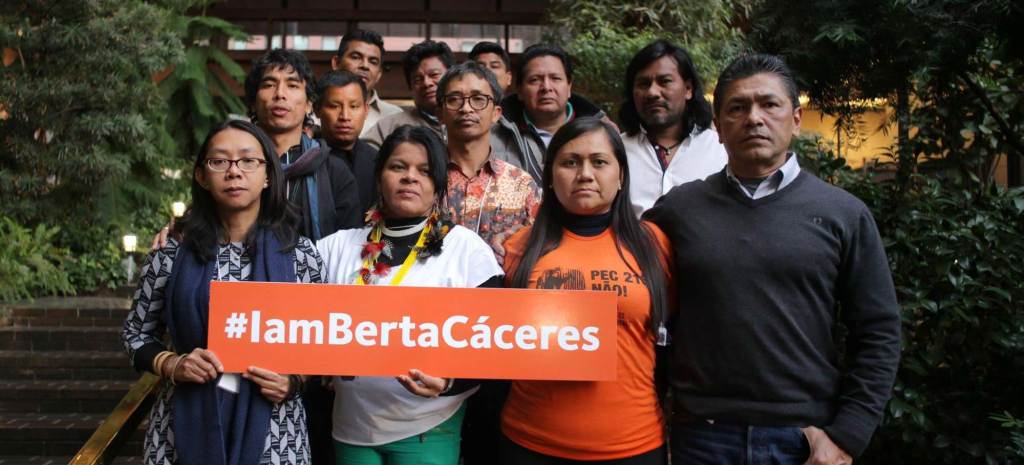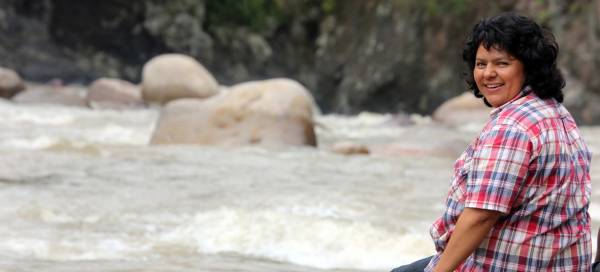
When Leonardo DiCaprio accepted his Oscar for Best Actor earlier this year, he made a point of highlighting the rights and plight of indigenous people, knowing millions of people were watching. Not long after, Honduran indigenous rights leader Berta Cáceres was assassinated, bringing a wave of international media attention to the cause she spent her life fighting for: defending the rivers and forests of the indigenous Lenca peoples.
While there has been increasing attention to indigenous rights, most people still don’t understand these issues and how they connect to their own lives.
I thought it would be useful to lay out the basics of what indigenous rights are, why exactly these communities are being threatened, why they play an essential role in addressing climate change.
What we mean by “indigenous peoples”
Accessibility Statement
- All videos produced by the Ford Foundation since 2020 include captions and downloadable transcripts. For videos where visuals require additional understanding, we offer audio-described versions.
- We are continuing to make videos produced prior to 2020 accessible.
- Videos from third-party sources (those not produced by the Ford Foundation) may not have captions, accessible transcripts, or audio descriptions.
- To improve accessibility beyond our site, we’ve created a free video accessibility WordPress plug-in.
There is no single definition of “indigenous peoples” that everyone accepts. The United Nations says indigenous peoples can often be traced back to pre-colonial societies and have strong ties to their territories and surrounding natural resources. Many have their own distinct languages, cultures, and beliefs, but they are usually not the dominant groups in the countries where they live.
Also called tribal peoples, first nations, aboriginals, Native Americans, or adivasi, indigenous peoples are found on every continent, from the North Pole to Tierra del Fuego. The UN estimates there are more than 370 million of them throughout the world.
The connection between indigenous peoples and natural resources
To make a living, indigenous communities often depend on natural resources that can be found in and around their villages— typically on land they have occupied for generations. This means farming, fishing, tending, and sustainably harvesting trees and other resources that come from the forests.
In some regions indigenous peoples have lived together with other groups for a long time. Many now live in cities and towns. But in more remote forested, mountainous, arid, and polar areas, tens of millions of indigenous people have remained relatively isolated. In those areas indigenous cultures tend to be closely linked to the local environments—the only way they have been able to survive is through a deep knowledge and understanding of their surroundings.
Accessibility Statement
- All videos produced by the Ford Foundation since 2020 include captions and downloadable transcripts. For videos where visuals require additional understanding, we offer audio-described versions.
- We are continuing to make videos produced prior to 2020 accessible.
- Videos from third-party sources (those not produced by the Ford Foundation) may not have captions, accessible transcripts, or audio descriptions.
- To improve accessibility beyond our site, we’ve created a free video accessibility WordPress plug-in.
For centuries, the more remote indigenous areas were basically neglected. Politicians and companies saw them as useless wastelands. They were so inaccessible and had such difficult environments that no outsiders really wanted them. This meant that indigenous peoples had access to few government services, like health or education. But it also meant they were largely left alone.
But as the world’s population and income grew and countries urbanized, wealthy investors have moved further into remote areas, looking for land and raw materials. They cleared forests for cattle and crops, sliced up mountains looking for metal, dammed rivers for electricity, grabbed the coasts to grow salmon and shrimp, and drilled for oil in the farthest reaches of the Artic and the Amazon.
While this has been going on for most of the last half century, it really took off over the past fifteen years. Energy, minerals, and food prices rose so much that it became profitable to produce them just about anywhere.
The connection to climate change
Accessibility Statement
- All videos produced by the Ford Foundation since 2020 include captions and downloadable transcripts. For videos where visuals require additional understanding, we offer audio-described versions.
- We are continuing to make videos produced prior to 2020 accessible.
- Videos from third-party sources (those not produced by the Ford Foundation) may not have captions, accessible transcripts, or audio descriptions.
- To improve accessibility beyond our site, we’ve created a free video accessibility WordPress plug-in.
Trees help fight climate change. They absorb carbon dioxide from the atmosphere, carbon dioxide that otherwise contributes to global warming. By providing shade and pumping water back into the atmosphere, they also help cool the lands around them.
So even though indigenous peoples may be far from major cities, their efforts to protect their forests, plants, and animals help all of us. They slow down climate change all over the world, giving countries precious time to shift away from fossil fuels. Some studies suggest that forests could provide about one third of all the reductions in global carbon emissions over the next few decades. Indigenous peoples manage a large share of those forests, and when their rights are protected they in turn can protect the forests more effectively.
And that’s not all: By protecting the other plants and animals in their forests, indigenous communities are preserving genetic resources that will be important to produce drugs in the future. The same is true of new varieties of crops for food. In a world where water scarcity is an increasingly critical issue, their importance of their efforts to protect the water in remote areas can’t be overstated.
Why indigenous communities are under threat
Even though indigenous peoples have been living in these remote areas for generations, they often don’t have any title to their land. This makes them vulnerable to outside interests who want their trees, rivers, and resources. Even when the communities do have a title, governments are often unwilling to intervene when powerful interests try to grab the resources for themselves.
Many governments have allowed oil companies, mining concessions, and plantations on indigenous lands. They have stood by while companies spill oil and mining waste into villagers’ rivers, while ranchers and farmers take their land, and while illegal miners and drug traffickers move in and do their business out of sight.
With this invasive activity on their traditional lands and little protection or accountability among the officials who should be responsible, indigenous communities are left to stand up for themselves—often in the face of immense threats. Simply put, powerful firms and growers don’t like when indigenous people get in the way of their operations, and their profit. They see them as an irritation at best, and at worst, disposable.
The result is near constant intimidation. Throughout Latin America, indigenous activists in remote areas have been charged with crimes they didn’t commit. Hundreds have been killed by ranchers, company thugs, and drug traffickers—and in some cases, even government officials. According to Global Witness, more than 1,000 land and environmental activists have been killed since 2002. Two-fifths of them were indigenous.
What we need to do now
Supporting indigenous efforts to protect their natural resources and their cultures is, plainly, the right thing to do. But if that’s not enough, we—many of us urban people who are increasingly disconnected from nature—depend on indigenous peoples for the things we need to keep our planet healthy.
It’s time we recognize that all of these issues are connected. The first thing we need to do is to encourage governments to take steps to stop the vicious killing of the people protecting our environment. The second is to recognize them as the stewards of their ancestral lands, and lend them a hand as they manage them.

